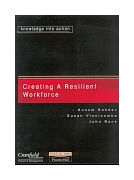Creating a Resilient
Workforce
Managing the upside of downsizing
John Bank, Sue Vinnicombe,
Kusum Sahdev
In Detail
Publication Date: November
2000
Making staff redundant is
still a process many companies are forced to go through even in times of economic
stability and modest growth. Whilst considerable attention is paid to the treatment of
staff made redundant, those who keep their jobs are expected to work harder than ever with
the constant worry that next time it may be them. The challenge for companies is how to
create a loyal and motivated workforce among those left behind.
This new report from
Cranfield School of Management sets out how a company can ensure that the core workforce
remains focussed, productive and committed to realising the benefits of downsizing. Based
on unique research carried out with over 60 large organisations, the report distils
information gathered from interviews with senior HR professionals and managers. It
provides a variety of models to enable organisations to effectively manage their workplace
both during and after a round of redundancies.
Contents include:
- What
is downsizing?
- How
should the process be handled?
- The
impact of downsizing on the survivors
- UK
and US cultures
- In-depth
case studies
- Key
lessons
- Future
Challenges
Contents
- Introduction
1 BACKGROUND
- Executive
summary
- Trends
in downsizing
- Implementing
downsizing - is there a best way?
- Reasons
for downsizing
- Benefits
of downsizing
- The
financial downside of downsizing
- The
case for resilience
- BT
case study - from betrayal to resilience
- Conclusion
2 HR PROFESSIONALS'
OBSERVATIONS OF THE SURVIVOR ISSUES
- 2.1
Executive summary
- 2.2
Introduction
- 2.3
Background information on downsizing
- 2.4
Perceptions of survivors' reactions
- 2.5
Perceptions of survivors' attitudes to work-related aspects
- 2.6
Survivors' performance
- 2.7
Survivors' expectations
- 2.8
Overview of the outcomes of downsizing
- 2.9
Conclusion
3 CASE STUDY: BARCLAYCARD
- 3.1
Executive summary
- 3.2
Introduction
- 3.3
Reasons for downsizing
- 3.4
Strategies to implement downsizing
- 3.5
HR strategies/policies to manage downsizing
- 3.6
Descriptions of key survivor issues
- 3.7
Conclusion
4 CASE STUDY: SKF (UK) LTD
- 4.1
Executive summary
- 4.2
Introduction
- 4.3
Reasons for downsizing
- 4.4
Strategies used to downsize
- 4.5
HR strategies used to manage downsizing
- 4.6
Description of key survivor issues
- 4.7
Conclusion
5 CASE STUDY: MEGATEX
- 5.1
Executive summary
- 5.2
Introduction
- 5.3
Reasons for downsizing
- 5.4
Strategies to implement downsizing
- 5.5
HR implementation strategies for downsizing
- 5.6
Description of key survivor issues
- 5.7
Conclusion
6 CASE STUDY: BEDFORDSHIRE
COUNTY COUNCIL
- 6.1
Executive summary
- 6.2
Introduction
- 6.3
Reasons for downsizing
- 6.4
Strategies to implement downsizing
- 6.5
HR strategies/policies to manage downsizing
- 6.6
Description of key survivor issues
- 6.7
Conclusion
7 CROSS-CASE COMPARISONS AND
BUILDING THE CONTEXT OF DOWNSIZING
- 7.1
Executive summary
- 7.2
Summary of findings from the four cases
- 7.3
Emerging categories
- 7.4
Developing a model for the context of downsizing
- 7.5
Underlying implications of restructuring/redesign strategies
- 7.6
Conclusion
8 SURVIVORS' REACTIONS
- 8.1
Executive summary
- 8.2
Introduction
- 8.3
Megatex: low frequency/reactive reasons for downsizing
- 8.4
BCC: high frequency/reactive reasons for downsizing
- 8.5
SKF (UK): high frequency/proactive reasons for downsizing
- 8.6
Barclaycard: low frequency/proactive reasons for downsizing
- 8.7
Conclusion
9 CREATING RESILIENCE THROUGH
BUILDING TRUST, COMMITMENT AND MOTIVATION
- 9.1
Executive summary
- 9.2
Implications of the findings
- 9.3
Trust as the precursor to creating resilience
- 9.4
Strategies for building trust, commitment and motivation
- 9.5
HR implications
- 9.6
Middle managers' role in building trust, commitment and motivation
- 9.7
Conclusion
APPENDIX
- A.1
Executive summary
- A.2
Case study methodology
- A.3
Selection of cases
- A.4
Phase One
- A.5
Phase Two
- 190
pages
Księgarnia nie działa. Nie odpowiadamy na pytania i nie realizujemy zamówien. Do odwolania !.


